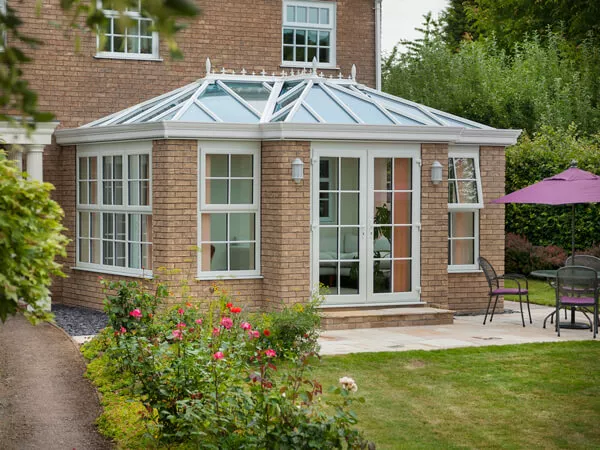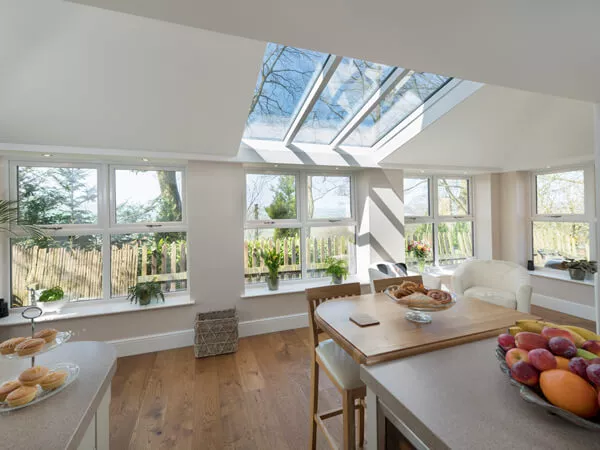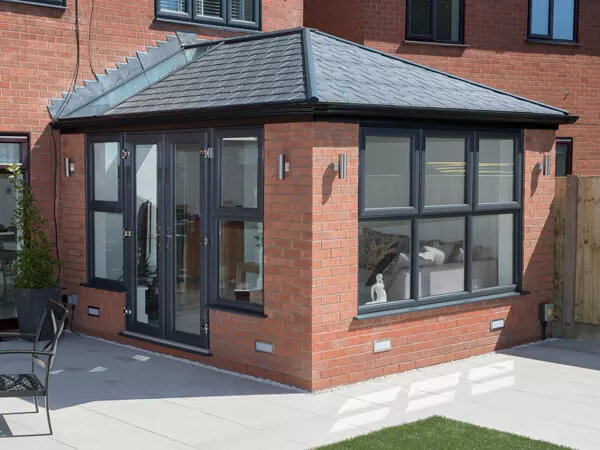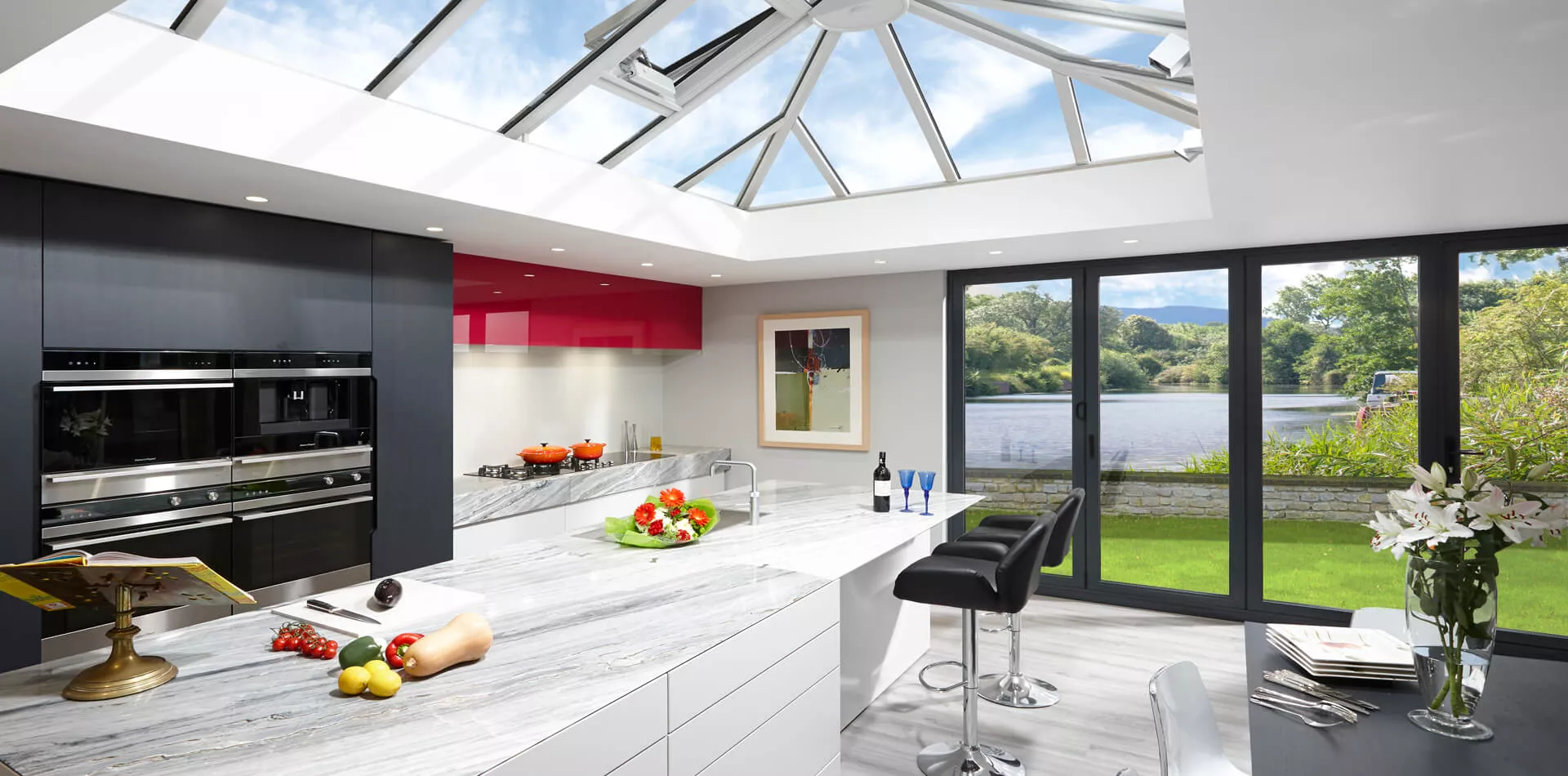What's the difference between a conservatory, orangery and an extension?
This is by far one of our most popular questions. Nowadays, it is not as easy to decipher what makes a living space a conservatory, orangery or extension. Your living space can be a combination of anything you want it to be, so the answer is not black and white. Previously, to be considered a conservatory an installation would need to be predominantly glass with a glass roof and walls. This has changed and now many customers are requesting a conservatory but opting for a tiled roof for a more pleasant temperature year round, and dwarf walls for increased insulation.
Typically, there is much more brickwork involved in an orangery than a conservatory. The aluminium pillars and brickwork add to a heightened sense of privacy and warmth, creating a deluxe feel. Orangeries will often consist of a pelmet around the roof, adding to the energy efficiency of the roof. As for the style, it can be completely adapted to your taste. Choose a glass lantern, solid tiled roof or go for something completely different!

If you’re looking for a more coherent look, home extensions blend in with the style of your home. Often they have more of a solid feel with more brickwork and will have some kind of solid tiled roof. Home extensions are extremely usable all year as they will stay at an enjoyable temperature throughout the year.
Don’t get bogged down by definitions. Speak to an ERG advisor who can guide you through the process in finding the perfect living space that may even be a combination of all three.

Should I choose a tiled roof or a glass roof?
Many of our customers are undecided between a tiled roof or glass roof. When deciding which to go for, consider the function of the room, the direction it faces and your budget. A glass roof is a favourite among our nature-loving customers as they are given a clear view of the outside, and natural light will fill their living space. Recent advancements in solar control glazing means that your room will stay at a pleasant temperature rather than overheating in the height of summer.
A solid tiled roof enables you to make the most out of your extension throughout every season, regardless of the temperature outside. You can even add full length glass panels or Velux windows, which gives you the best of both worlds with both solid tiles and glass used.
Our friendly team can issue guidance on finding the best roof for your living space, with special attention to your specific needs and budget.

MORE COMMON QUESTIONS
Our helpful advisors are here to answer all of your questions. Take a look at the answers to our most common questions below.
Will it be too hot in summer and too cool in winter?
When our customers tell us they want to use their living spaces all year, we assure them that this is possible! Each and every living space at ERG has been designed to be used throughout the year. Our solar control glazing is great at maintaining a consistent temperature. If you want to go that extra mile in achieving a year-round extension, we recommend a tiled roof.
Do you manufacture your own roofs?
Yes, we do. ERG is part of the Conservatory Outlet Group of companies. Our sister company, Conservatory Outlet, is one of the top manufacturers of roof products across the UK. Made in our manufacturing facility in West Yorkshire, all our roofs are UK-made, with a focus on quality craftsmanship.
As it is our sister company, we are able to regularly communicate with our manufacturer to guarantee that top quality roofs are constantly being produced for our customers.
Can I choose different roof tiles to match my home?
Yes, of course! You can decide between a vast selection of shingle and slate roof tiles to complement your home. If you are looking for roof tiles to match your existing tiles, we can do our best to find an exact match. An ERG advisor will be happy to talk you through your options.
I’m curious about energy rated windows! What do 'A' rated windows mean?
A-rated windows are the very best when it comes to energy efficiency. This guidance has been issued by the UK’s national system for rating the energy efficiency of windows. It is also recognised within the Building Regulations to show compliance for your replacement windows installation.
Some companies can throw around the term ‘energy efficient’ without it meaning anything. The ratings label is a great way for consumers to make sure they are making knowledgeable decisions about the energy efficiency of their windows, without relying on companies simply telling them what to think. The traffic-light A-E ratings guide is similar to what is used on fridges, freezers and washing machines.
What is solar control glazing?
Solar glazing works by preventing excessive heat from being transmitted into your room and stopping internal heat from escaping. You can choose from an assortment of tinted options for different levels of light transmission and heat retention. Talk to an ERG advisor for more details.
Can I match to my existing bricks?
At ERG we make a special effort to acquire bricks that are a close match to your current property so your extension is a seamless addition to your home. Please note that we cannot guarantee that they will look identical because there could be weathering or manufacturing differences between the two sets of bricks. If you are unhappy with the closest match, for an additional cost we are able to tint your new bricks to look like the current brickwork.
Do I need Building Regulations Approval?
The majority of extensions need approval under Building Regulations. However, there are a few extensions that don’t require this. Do not worry about the uncertainty as ERG will send an experienced surveyor to your home to advise you on the requirements. If approval is needed, ERG will speak with the relevant local authority to arrange this, ensuring there is minimal hassle for you.
Do I need planning permission?
Extensions & Conservatories
You don’t require planning permission if the extension meets certain rules. This is called ‘permitted development’.
If your extension will have one storey, you don’t need planning permission as long as:
- it’s located at the back of the house
- it doesn’t go back further than 3 metres if it’s a terraced house, or 4 metres
- if it isn’t the height of the eaves (where the wall meets the roof) is no higher than 3 metres
- it’s not higher than 4 metres, including sloping roofs
- it doesn’t cover more floor area than your house does
- it doesn’t take up half the ‘curtilage’ – the grounds behind your home
- it isn’t within a conservation area
If you want to add a porch to a front door, back door or side door on your house,
different rules apply.
Porches
You won’t need planning permission to add a porch to a front door, back door or side door on your house as long as:
- its footprint (the total floor area it takes up) is no greater than 3 square metres
- there’s at least 2 metres between the edge of the porch and any boundary facing a road
- it isn’t taller than 3 metres
- it isn’t within a conservation area
How long will it take to build my new living space?
There are many factors that need to be considered before we can give you an accurate estimate of timings. It often depends on planning requirements and how complicated the project is. You can request a copy of ‘What happens next’ for a loose guide of the timeline.
What is a test dig?
It is important for us to carry out a test dig to be certain that the local ground conditions can withstand a traditional concrete base and foundation. This must be tested before installing the living space. In the event that the ground is not found to be suitable, we will recommend alternative foundations, such as a specialist pile foundation or concrete raft.
What is a cavity tray?
A cavity tray stops moisture from penetrating the outer wall that will eventually start to appear on the walls of your new extension. It is a series of high level damp proof courses that bridge a wall cavity. This directs moisture to the external face of a wall where the extension roof joins the house wall.
Do you offer finance to help me pay for for my new living space?
Yes. To make life easy for you, ERG Scotland can arrange a variety of affordable and convenient easy payment finance options (subject to application & status). Applying for finance is simple and we promise you a quick decision. Everything can be sorted out with you in the comfort of your home or at your local ERG Scotland Showroom, so you can enjoy whatever you’ve set your heart on right away.
What do we need to do when our finance is approved?
If you’re arranging your own finance, you’ll need to call us as soon as you get the go ahead. If you’re taking up one of our offers, the company will tell us both directly, so there’s no need to call as we will get in touch with you.
What happens if finance is refused?
Finance companies can turn down people for lots of reasons, for example if you’ve moved several times over the past few years. In these circumstances, we always do our best to help and sometimes it’s worth trying another provider, especially if they know you.
I’ve applied for finance with ERG Scotland. How long will approval take?
Sometimes our finance company will say ‘yes’ almost immediately and on other occasions it may take them a few days. This short delay can be for any number of reasons and you should not be unduly concerned.
ERG Scotland PROMISES
Every promise we make, we keep. Every time. Our promises are bold and are there to assure you that we’re completely confident in our products and our service.
Transparent Service
At ERG we realise the importance of gaining trust and not expecting it. We believe this is achieved through hard work, honesty, transparency of our services and valuing our customers.
Ethos of ERG Scotland
Our teams adhere to a strict ethos which is to achieve only the highest standards of excellence at all times. We listen to our customer’s needs and tailor our services to meet all individual requirements.
Comprehensive Guarantee
ERG Scotland offers a comprehensive guarantee across all products. Not only that, you will also be covered for both moving and non-moving parts. Our confidence in our products and dedication to our customers means we’ll be there for you well into the future.
Price Promise
Giving our customers complete confidence in the price that they pay is very important to us. So, if you, or any customer, can find the same product specification and service commitment cheaper elsewhere, within 14 days, we’ll refund the difference.
OUR FINANCE CALCULATOR
See how affordable your home improvement can be with our Finance Calculator.
NEED MORE ANSWERS?
Simply fill in your details below and one of our customer advisors will get in touch to answer any of your questions.



